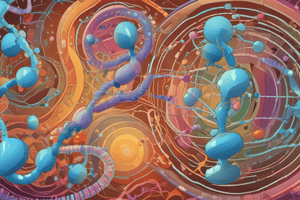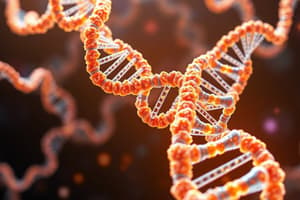Podcast
Questions and Answers
Which of the following is NOT a level of protein structure?
Which of the following is NOT a level of protein structure?
- Quaternary (correct)
- Secondary
- Primary
- Tertiary
What type of bond is primarily responsible for maintaining the shape of a protein?
What type of bond is primarily responsible for maintaining the shape of a protein?
- Hydrogen bonds (correct)
- Ionic bonds
- Covalent bonds
- Disulfide bonds
Which of the following is a key reason for understanding protein sequence?
Which of the following is a key reason for understanding protein sequence?
- To develop new antibiotics
- To create new vaccines
- To design new enzymes
- All of the above (correct)
What is the difference between a peptide and a polypeptide?
What is the difference between a peptide and a polypeptide?
What is the central dogma of molecular biology?
What is the central dogma of molecular biology?
What is the name of the molecule that Friedrich Miescher discovered in 1868 and called 'nuclein'?
What is the name of the molecule that Friedrich Miescher discovered in 1868 and called 'nuclein'?
What year did Carl Woese propose that the earliest life forms relied on RNA for genetic information and biochemical processes?
What year did Carl Woese propose that the earliest life forms relied on RNA for genetic information and biochemical processes?
Which of these scientists won the Nobel Prize for discovering how RNA is synthesized?
Which of these scientists won the Nobel Prize for discovering how RNA is synthesized?
What is the primary difference between the sugar component in RNA compared to DNA?
What is the primary difference between the sugar component in RNA compared to DNA?
Which of the following nitrogenous bases is found in RNA but NOT in DNA?
Which of the following nitrogenous bases is found in RNA but NOT in DNA?
What is the typical structure of RNA?
What is the typical structure of RNA?
The content mentions that RNA interference occurs in plants. What does RNA interference involve?
The content mentions that RNA interference occurs in plants. What does RNA interference involve?
What is the name of the RNA molecule that carries genetic information from DNA to ribosomes for protein synthesis?
What is the name of the RNA molecule that carries genetic information from DNA to ribosomes for protein synthesis?
What is the function of tRNA in protein synthesis?
What is the function of tRNA in protein synthesis?
Which RNA molecule is responsible for carrying the genetic code from DNA to the ribosome for protein synthesis?
Which RNA molecule is responsible for carrying the genetic code from DNA to the ribosome for protein synthesis?
What is the role of the start codon 'AUG' in protein synthesis?
What is the role of the start codon 'AUG' in protein synthesis?
Which of the following statements correctly describes the function of rRNA?
Which of the following statements correctly describes the function of rRNA?
What is the significance of the G:::C rich content in rRNA?
What is the significance of the G:::C rich content in rRNA?
How many codons are required to code for a protein sequence of 10 amino acids?
How many codons are required to code for a protein sequence of 10 amino acids?
Which of the following is NOT a characteristic of tRNA?
Which of the following is NOT a characteristic of tRNA?
What is the difference in ribosome structure between prokaryotes and eukaryotes?
What is the difference in ribosome structure between prokaryotes and eukaryotes?
Which of the following is an example of a stop codon?
Which of the following is an example of a stop codon?
What distinguishes a protein's structure from its function?
What distinguishes a protein's structure from its function?
Flashcards
Central Dogma of Molecular Biology
Central Dogma of Molecular Biology
The process by which DNA is transcribed to RNA and then translated into protein.
Nuclein
Nuclein
The original term used by Miescher in 1868 to describe RNA found in the nucleus.
RNA interference
RNA interference
A biological process where introduced genes can silence homologous genes in plants.
Homo sapiens Insulin
Homo sapiens Insulin
Signup and view all the flashcards
Ribose
Ribose
Signup and view all the flashcards
Peptides
Peptides
Signup and view all the flashcards
Uracil
Uracil
Signup and view all the flashcards
Single-Stranded
Single-Stranded
Signup and view all the flashcards
Polypeptides
Polypeptides
Signup and view all the flashcards
tRNA
tRNA
Signup and view all the flashcards
Protein structure
Protein structure
Signup and view all the flashcards
mRNA
mRNA
Signup and view all the flashcards
Central Dogma
Central Dogma
Signup and view all the flashcards
Codon
Codon
Signup and view all the flashcards
Amino Acids
Amino Acids
Signup and view all the flashcards
Transcription
Transcription
Signup and view all the flashcards
Translation
Translation
Signup and view all the flashcards
Genetic Code
Genetic Code
Signup and view all the flashcards
Base Pairing
Base Pairing
Signup and view all the flashcards
Study Notes
Introduction to Biology (BIOL 1005) - Lectures 2-3
- Course offered by Allen Cheung on January 15, 2025
- Focuses on the central dogma of molecular biology and RNA, along with the structure and function of proteins.
The Central Dogma of Molecular Biology
- DNA replicates, transcribes to RNA, then translates to protein.
- DNA → RNA → Protein
- The process includes replication, transcription (DNA to RNA), reverse transcription (RNA to DNA), and translation (RNA to protein), and RNA replication.
History of RNA
- Friedrich Miescher discovered RNA in 1868, initially calling it "nuclein."
- RNA's acidic properties led to being classified as nucleic acid.
- By 1939, the role of RNA in protein synthesis was suspected.
- Severo Ochoa won the 1959 Nobel Prize for his work on RNA synthesis.
- Carl Woese (1967) proposed that early life relied on RNA for genetic information and biochemical processes.
- RNA interference (RNAi) and gene regulatory RNAs were discovered in 1990. This led to exploration of drug development using RNA-based molecules (siRNA).
RNA
- Ribonucleic acid (RNA)
- RNA differs from DNA due to its sugar component (ribose).
- RNA has the bases Adenine (A), Uracil (U), Cytosine (C), and Guanine (G)
- RNA is a single-stranded structure.
- RNAs do not form base pairing
RNA Nucleotides
- The sugar in RNA nucleotides is ribose.
- RNA is single-stranded, so no base pairing.
Structure of RNA
- Located in the nucleus and cytoplasm
- Backbone is comprised of ribose sugar and phosphates.
- Contains nitrogenous bases: adenine, uracil, cytosine, and guanine.
- Typically forms an alpha-helix (mostly), or 3D structures.
RNA Folding
- Primarily linear (alpha-helix).
- Can fold on itself to form 2-D and 3-D structures (various shapes).
Influenza A viral RNA
- The structure of influenza A viral RNA was studied and characterized.
Classic types of RNA
- mRNA: messenger RNA
- tRNA: transfer RNA
- rRNA: ribosomal RNA
- These work together to generate proteins using instructions from DNA/cell. They are only temporary within cells
Eukaryotic Cell
- DNA → RNA → Protein in eukaryotic cells
- Process occurs within the cell, specifically with the nucleus being involved in transcription and processing of mRNA
Messenger RNA (mRNA)
- A molecule of RNA encoding a chemical "blueprint" for a protein product.
- Transcribed from the DNA gene template and carries the coding information.
- Arranges genetic information in three-base codons, each specifying an amino acid, except the stop codon.
mRNA in Prokaryotic and Eukaryotic Cells
- Prokaryotes transcribe and translate mRNA simultaneously.
- Eukaryotes process mRNA in the nucleus before exporting it to the cytoplasm for translation.
Ribosomes
- rRNA (Ribosomal RNA) is the central component of ribosomes, present in >80% of cells.
- Ribosomes are composed of two subunits (prokaryotes: 70S [50S + 30S]; eukaryotes: 80S [60S + 40S]).
- Ribosomes contain rRNA and proteins
rRNA Structure
- rRNA has distinct domains (5' domain, central domain, 3' major domain, 3' minor domain), crucial portions of the ribosomes.
Ribosome Function
- Ribosomes are located in the cytoplasm.
- They facilitate mRNA's translation into proteins.
- Ribosomes require tRNA to perform this translation.
tRNA Structure
- tRNA (transfer RNA) is among the smallest RNAs (75-93 nucleotides or nt).
- It recognizes mRNA codons and carries specific amino acids.
- tRNA is transcribed by RNA polymerase III and is widespread throughout the genome, which may include introns.
Transcription and Translation
- A YouTube video on transcription and translation is referenced.
Summary
- Nucleotides for RNA
- RNA structure and functions (mRNA, rRNA, tRNA)
Proteins
- Composed of 20 amino acids (AAs).
- Encoded by codons (combinations of A, U, C, and G).
- Structure determines function.
Amino Acids
- Full name, 3-letter short name, 1-letter symbol
Table of Codons
- A table showing the correspondence between codons and amino acids.
Essential and Non-Essential Amino Acids
- Essential amino acids cannot be synthesized by the body and must be obtained from food.
- Non-essential amino acids can be synthesized within the body.
Reading the Encoded Sequence
- Example: A DNA sequence is translated into an mRNA sequence, and then into a protein sequence.
- The correlation between specific amino acids with mRNA codons.
Protein Sequence
- Example protein sequence (MGWN) and description of peptides.
Short Exercise
- A short exercise on translation (HIV nef gene sequence) is presented, including the steps to translate a gene sequence into a protein sequence..
Peptides
- Short chains of amino acids.
- Linked via peptide bonds.
Polypeptides
- Generally chains containing >10 but <50 amino acids.
- Parts of the protein, also known as oligopeptides (shorter sequences).
- Linked by disulfide bonds (e.g., insulin), creating protein structures.
Polypeptide Functions
- Polypeptides perform varied functions in the body.
Proteins (Detailed)
- Consist of polypeptides arranged in secondary, tertiary, and quaternary structures.
- Structure (conformation) dictates specific function and protein-protein interactions.
Protein Structure
- Levels of protein structure (primary, secondary, tertiary, quaternary)
- Describing these in detail.
Shape of the Protein
- The shape of a protein is determined by the interactions between amino acids and side chains.
Central Dogma Video
- A YouTube video on the central dogma is referenced (link).
Summary
- Amino acids -> Peptides -> Polypeptides -> Proteins.
- Protein structure (1°, 2°, 3°, 4°) determines protein function.
- Proteins are stabilized through bonds.
- Understanding protein structure and amino acid composition is crucial.
SARS-CoV-2 Spike Protein
- COVID-19 virus protein structure, showing the coding sequences and functional regions.
Studying That Suits You
Use AI to generate personalized quizzes and flashcards to suit your learning preferences.



